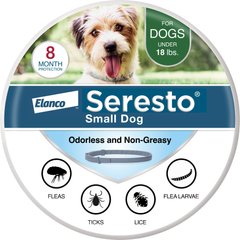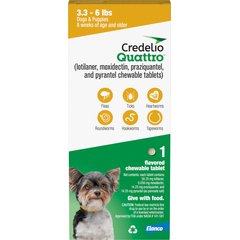6 Tick-Borne Diseases in Dogs and How To Help Your Pup

Photo by Adobe Stock/bnenin
Whether a fervent hiker or a lap dog who just pops outside for bathroom breaks, all dogs are at risk of getting bitten by a tick in their lifetime.
Some tick bites are just annoying, but others can lead to tick-borne diseases. And while many of these diseases are treatable, each requires immediate attention to prevent potentially life-threatening conditions.
Pet parents, read on to learn about prevention, treatment, and signs of common tick-borne diseases in dogs.
Key Takeaways
- Tick-borne diseases in dogs are spread through tick bites.
- It generally takes at least several hours of feeding on their host for ticks to transmit disease.
- Symptoms may include fever, lethargy, appetite loss, joint swelling, bruising, vomiting, weight loss, or neurological changes.
- Many tick-borne diseases in dogs respond to antibiotics or antiprotozoal drugs, and early treatment greatly improves recovery.
- Prevention includes using flea and tick preventives, avoiding tick-dense habitats, checking daily for ticks, removing ticks safely, and vaccinating for Lyme disease when recommended.
What Are Tick-Borne Diseases in Dogs?
Tick-borne diseases are infections that are transmitted to an animal or a human through a tick bite (specifically, from the tick’s saliva, which carries pathogens present in the tick). These pathogens then spread via the bloodstream and can affect many body systems.
Ticks are tiny parasites that feed on the blood of humans and animals, including rodents, deer, birds, and pets. They are found all over the U.S., particularly in grassy or wooded areas on the West Coast and east of the Rocky Mountains.
Tick bites are common, especially during the spring and summer. But not every dog tick bite will lead to a disease. A tick needs to feed on its host for several hours before transmitting disease—typically between three and 48 hours, depending on the species, explains Michael Kearley, DVM.
So with a little extra vigilance and preventive measures, you can reduce your pup’s chances of disease.
Types of Tick-Borne Diseases in Dogs
If you’re aware that your dog recently received a tick bite, be on the lookout for symptoms of any of the following canine tick-borne diseases.
1. Anaplasmosis
There are two types of canine anaplasmosis found in North America:
- Anaplasmosis phagocytophilum is carried by black-legged ticks, often in the Northeast, upper Midwestern, and Western United States. This disease infects a dog’s white blood cells, and symptoms may include lameness, joint pain, fever, fatigue, and loss of appetite.
- Anaplasmosis platys is less common and one of several diseases that can be carried by the brown dog tick. This condition can cause a decrease in platelets, which may reduce blood clotting. Bruising may be one sign of this disease.
2. Babesiosis
Like anaplasmosis, babesiosis is transmitted by infected ticks. Some studies show that it can also be transmitted through the bite of an infected dog or by an infected pregnant dog passing it to her pups, but Dr. Kearley says this is much less common.
Babesiosis affects a dog’s red blood cells and platelets, leading to symptoms like jaundice, pale gums, weakness, and pinpoint bruising.
3. Ehrlichiosis
There are several types of ehrlichiosis, a disease that may be carried by one of several types of ticks. Most cases of ehrlichiosis in dogs are reported in the Southeast and South Central U.S.
Early signs of this disease may include fever, weight loss, poor appetite, lameness, lethargy, and abnormal bleeding. If dogs with ehrlichiosis aren’t treated early on, their symptoms may become chronic and potentially fatal.
4. Hepatozoonosis
Unlike most tick-borne diseases in dogs, hepatozoonosis is not transmitted by tick bite. Instead, a dog can get hepatozoonosis by eating an infected tick or an infected wild animal.
There are two types of hepatozoonosis:
- H. americanum is more serious and requires targeted and prolonged treatment, started as early as possible. At its onset, pet parents may notice fever, chronic weight loss, thick ocular discharge, generalized pain, and stiffness.
- H. canis is less severe and causes symptoms like fever, pale gums, poor appetite, and sluggishness.
5. Lyme Disease
Lyme disease may be carried by black-legged ticks (deer ticks), and it can affect both dogs and humans. When a dog is infected with Lyme disease, they can experience a number of symptoms, including:
- High fever
- Joint pain
- Lethargy
- Lameness
- Increased thirst
- Decreased appetite
- Swollen lymph nodes
When treated early, Lyme disease is a manageable disease in dogs. But without treatment, some cases can be life-threatening.
6. Rocky Mountain Spotted Fever
Like Lyme disease, Rocky Mountain spotted fever (RMSF) can affect both dogs and humans, as well as other species. Symptoms of RMSF in dogs can lead to:
- A high fever
- Loss of appetite
- Enlarged lymph nodes
- Coughing or difficulty breathing
- Vomiting and diarrhea
- Abdominal pain
- Pain and swelling in the joints and muscles
- Weight loss
- Red spots or bruising
Symptoms often come on suddenly, and early treatment is essential. RMSF can be fatal if it’s not treated quickly.
Symptoms of Tick-Borne Diseases in Dogs

cunfek/E+ via Getty Images
There are many tick-borne disease symptoms in dogs that vary by infection and from dog to dog.
Dogs with a healthy immune system may not show any symptoms at all, Dr. Kearley says. But young dogs, older dogs, or dogs who already had compromised health could show symptoms as soon as one to three weeks after being bitten by an infected tick.
“If a pet parent notices that their dog is limping, has unexplained bruising, is drinking or urinating more often, or just seems ‘off,’ it’s best to seek care from your vet,” says Heather Loenser, DVM, chief veterinary officer of Suveto Veterinary Health.
If you notice any of the following symptoms of dog tick diseases in your pup, call your vet immediately:
- Lethargy
- Fever
- Loss of appetite
- Lameness and swelling of the joints
- Runny nose
- Nosebleed
- Joint pain
- Bruises on gums and belly
- Vomiting
- Weight loss
- Eye symptoms, such as thick eye discharge
- Neurological symptoms (such as seizures and lack of coordination)
- Swollen lymph nodes
How Tick-Borne Diseases in Dogs Are Treated
When it comes to tick-borne diseases in dogs, treatment depends on which infection they have and its severity.
“Most can be treated with specific oral antibiotics,” Dr. Loenser says. Depending on the case, treatment may also include fluids, anti-inflammatories, antiprotozoals, or other medications.
Dr. Loenser points out that many canine tick-borne diseases can be treated easily—as long as they’re detected early on.
“But if the diseases have been undetected for weeks or months, the treatments can be more complicated and less successful,” she warns.
How To Protect Your Dog Against Tick-Borne Diseases
Most dogs love any chance to run through a field or explore the woods with their family, and chances are your dog will encounter a tick sooner or later. The good news is that pet parents can take a number of safety measures to protect against dog tick diseases.
Start by talking to your veterinarian about flea and tick preventives. These won’t prevent tick bites entirely, but they do reduce the chances of a tick choosing your dog or remaining attached long enough to transmit disease.
Common types of flea and tick preventives for dogs include:
- Flea and Tick Collars: Worn around the neck, these collars slowly release active ingredients over time to repel or kill fleas and tick. For example, Seresto is a vet-recommend option that provides eight months of protection against fleas and ticks. Available without a prescription, the odorless, non-greasy Seresto collar is formulated for dogs and puppies at least 7 weeks old.
Recommended Product
- Oral Medications: Given by mouth, usually once a month, these are pills or chewable tablets that protect against fleas and ticks. Some, like Credelio Quattro, protect against internal parasites as well.
Recommended Product
- Topical Treatments (Spot-Ons): Typically used monthly, topical treatments, like K9 Advantix II, are applied directly to the skin to protect against fleas and ticks.
Recommended Product
Recommended Products
You can also ask your vet about the Lyme disease vaccination for dogs, but this will only help protect your pup from one of several possible diseases.
When you’re walking your dog, take care to avoid tall grasses and wooded areas. But remember that ticks can be found almost anywhere—even in your backyard—so dogs who go outdoors should have daily tick checks.
If you find a tick, remove it immediately. While wearing gloves, grab the tick by its base and gently pull it from the dog’s skin. Place the tick in a sealable container with rubbing alcohol to kill it. (Don’t crush the tick with your fingers as this can expose you to infectious organisms in the tick.) If you don’t feel comfortable removing the tick, Dr. Loenser says, you can call your vet and ask for help.
FAQs About Tick-Borne Diseases in Dogs
Are tick-borne diseases curable in dogs?
Most tick-borne diseases in dogs are curable when treated early on. But the longer a dog goes with untreated symptoms, the harder it will be to protect them from long-lasting and potentially life-threatening effects. “Early detection is key,” Dr. Loenser says.
How soon after a tick bite does a dog get sick?
Often dogs will not show symptoms of tick-borne disease even if they have been bitten by a tick that has transmitted one. However, it is possible to see symptoms of a tick-borne illness within one to three weeks after they were bitten.
Should I take my dog to the vet after a tick bite?
You don’t need to take your dog to the vet after a tick bite unless you need help removing the tick. But you should monitor your pup’s behavior in the weeks that follow. If you notice any symptoms, make an appointment with your vet right away.
Attributions
Expert input by Michael Kearley, DVM, and Heather Loenser, DVM, chief veterinary officer of Suveto Veterinary Health.








